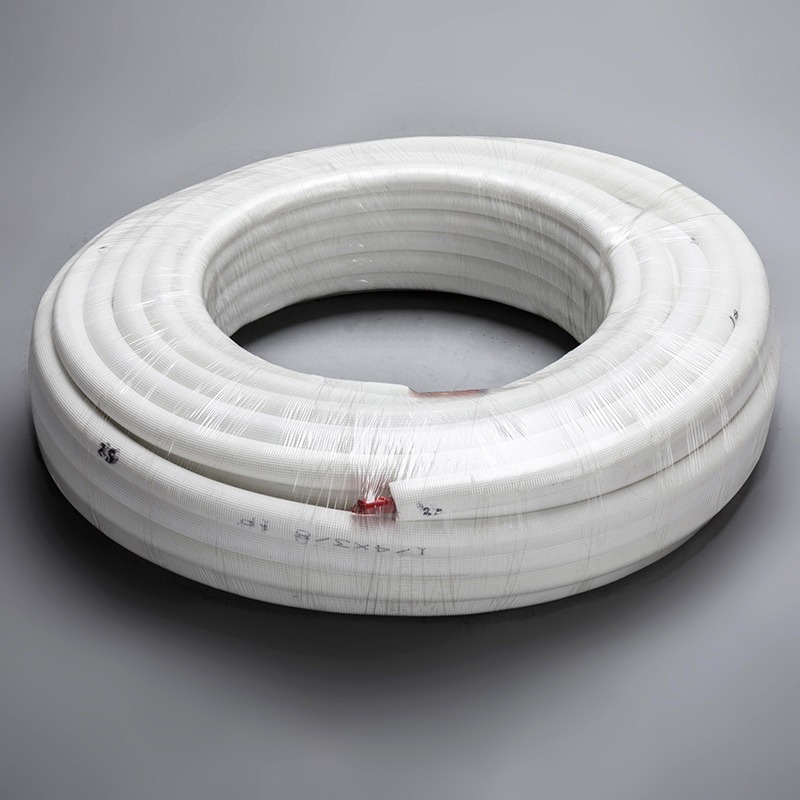Aluminum vs Copper Piping: Which is Better for Air Conditioning?

Choosing the right piping material is essential for maximizing the efficiency of air conditioning systems. When comparing aluminum vs copper piping in air conditioning systems, both materials stand out for their distinct advantages and applications. Copper is renowned for its excellent thermal conductivity, strength, and durability, making it a dependable option for high-performance HVAC systems. In contrast, aluminum is celebrated for its affordability, lightweight design, and versatility, which have made it increasingly popular in various air conditioning setups. A thorough comparison of aluminum and copper piping in air conditioning systems enables professionals to make well-informed decisions based on specific needs and priorities.
Thermal Conductivity and Efficiency

Copper's Thermal Conductivity
Advantages of Copper in Heat Transfer
Copper exhibits exceptional thermal conductivity, making it a preferred material for efficient heat transfer in air conditioning systems. The high thermal conductivity of copper allows rapid heat absorption and dissipation, ensuring effective cooling performance. Copper pipes are widely used in heat exchangers and refrigerant systems due to their ability to handle extreme pressures and temperatures. The superior heat transfer rate of copper enhances the overall energy efficiency of HVAC systems, contributing to sustainable cooling solutions.
Limitations of Copper in Certain Applications
Despite its excellent thermal properties, copper has certain limitations in specific applications. The higher cost of copper compared to aluminum can increase the initial investment for air conditioning systems. Copper's density also makes it heavier, which may pose challenges in installations requiring lightweight materials. In environments with high levels of corrosive agents, copper may require additional protective coatings to prevent degradation over time.
Aluminum's Thermal Conductivity
Benefits of Aluminum in Heat Transfer
Aluminum offers notable benefits in heat transfer applications, particularly in air conditioning systems. Although aluminum's thermal conductivity is lower than copper, its lightweight nature and affordability make it an attractive choice for many HVAC setups. Aluminum pipes are often used in heat exchangers where weight reduction is a priority. The combination of good thermal performance and cost-effectiveness positions aluminum as a viable alternative to copper in certain scenarios.
Situations Where Aluminum Falls Short
Aluminum's lower thermal conductivity compared to copper can limit its effectiveness in high-performance cooling systems. The slower heat transfer rate of aluminum may result in reduced cooling efficiency, especially in demanding applications. Aluminum pipes also require more energy to heat and cool, leading to higher operational costs over time. Additionally, aluminum's susceptibility to damage under extreme pressures or temperatures may restrict its use in specific HVAC configurations.
Comparative Analysis
Which Material Offers Better Efficiency?
Copper outperforms aluminum in terms of thermal efficiency due to its superior conductivity. The ability of copper to transfer heat quickly ensures optimal cooling performance in air conditioning systems. Aluminum, while cost-effective, cannot match the efficiency levels provided by copper in high-demand environments. The choice between the two materials depends on balancing performance requirements with budget constraints.
Impact on Air Conditioning Performance
The material selected for air conditioning systems significantly impacts overall performance. Copper's high thermal conductivity enhances energy efficiency, reducing operational costs and improving system reliability. Aluminum, with its lightweight design, offers advantages in installations where weight is a critical factor. However, the lower cooling effectiveness of aluminum may affect the long-term performance of the system. A careful evaluation of system demands and priorities is essential when making a decision.
Durability and Longevity
Copper's Durability
Resistance to Corrosion
Copper piping demonstrates exceptional resistance to corrosion in various environments. The natural properties of copper create a protective oxide layer that shields the material from external damage. This characteristic enhances its durability, especially in plumbing and HVAC systems. Copper pipes maintain structural integrity even when exposed to moisture or varying temperatures. The ability to resist corrosion reduces the risk of leaks and ensures long-term reliability in air conditioning systems.
Lifespan in Various Environments
Copper pipes exhibit remarkable longevity across diverse conditions. In potable water services, copper piping has been known to last for over 50 years without significant deterioration. The strength and rigidity of copper contribute to its ability to withstand mechanical stress and environmental fluctuations. Applications in building construction, including heating and cooling systems, benefit from copper's extended lifespan. The durability of copper makes it a preferred choice for high-performance HVAC systems requiring minimal replacement over time.
Aluminum's Durability
Vulnerability to Corrosion
Aluminum piping offers natural resistance to corrosion due to its protective oxide layer. This feature minimizes the risk of rust and extends the lifespan of aluminum in air conditioning systems. However, aluminum is more susceptible to damage in environments with high salinity or acidic conditions. In such cases, the material may require additional protective coatings to prevent degradation. The vulnerability of aluminum under extreme conditions can impact its long-term performance in specific HVAC applications.
Protective Coatings and Their Effectiveness
Protective coatings enhance the durability of aluminum pipes in challenging environments. These coatings provide an additional barrier against corrosive agents, improving the material's resistance to wear and tear. The lightweight nature of aluminum, combined with effective coatings, ensures sustainability in compressed air piping systems and other applications. Maintenance of these coatings is essential to preserve the structural integrity of aluminum over extended periods.
Comparative Analysis
Which Material Lasts Longer in Real-World Conditions?
Copper outperforms aluminum in terms of longevity under real-world conditions. The superior strength and resistance to mechanical damage make copper a reliable option for HVAC systems. Aluminum, while durable, may face limitations in environments with extreme pressures or corrosive elements. The extended lifespan of copper in various applications highlights its suitability for long-term use in air conditioning systems.
Maintenance Requirements Over Time
Copper piping requires minimal maintenance due to its robust structure and resistance to environmental factors. Regular inspections are sufficient to ensure optimal performance. Aluminum pipes demand more frequent maintenance to address potential vulnerabilities and preserve protective coatings. The difference in maintenance needs influences the overall cost-effectiveness of each material. A thorough evaluation of system requirements helps determine the most suitable choice for air conditioning systems.
Cost Considerations
Initial Costs
Price of Copper Piping
Copper piping involves higher initial costs due to its premium raw material price and complex manufacturing process. The extraction and refinement of copper require significant energy and resources, contributing to elevated market prices. Copper's superior thermal conductivity and durability justify the expense for high-performance air conditioning systems. However, the upfront investment in copper piping often becomes a limiting factor for budget-conscious projects.
Price of Aluminum Piping
Aluminum piping offers a more affordable alternative with lower initial costs. The abundance of aluminum in the Earth's crust and its simpler extraction process reduce production expenses. Aluminum's lightweight nature also minimizes transportation costs, further enhancing its cost-effectiveness. Many HVAC professionals prefer aluminum for projects requiring economical solutions without compromising basic functionality. The affordability of aluminum piping makes it suitable for large-scale installations where budget constraints exist.
Long-Term Costs
Maintenance and Repair Expenses
Copper piping incurs minimal maintenance costs over time due to its robust structure and resistance to environmental factors. The natural protective oxide layer on copper prevents significant corrosion, reducing the need for frequent repairs. Aluminum piping, while durable, may require additional protective coatings in harsh environments. These coatings demand periodic maintenance to ensure long-term performance. The susceptibility of aluminum to damage under extreme conditions can increase repair expenses over the system's lifespan.
Energy Efficiency and Cost Savings
Copper piping enhances energy efficiency through its superior thermal conductivity. The rapid heat transfer capability of copper reduces energy consumption in air conditioning systems. Lower operational costs result from improved cooling performance and reduced energy usage. Aluminum piping, with its lower thermal conductivity, consumes more energy during operation. The slower heat transfer rate of aluminum impacts cooling efficiency, leading to higher utility bills over time. The energy savings associated with copper often offset its higher initial costs.
Comparative Analysis
Which Material is More Cost-Effective Overall?
Copper piping proves more cost-effective in the long term due to its durability, low maintenance requirements, and energy efficiency. The extended lifespan of copper reduces replacement needs, making it a reliable investment for high-performance systems. Aluminum piping, with its lower upfront costs, appeals to projects prioritizing affordability. However, the increased maintenance and operational expenses associated with aluminum can diminish its cost advantages over time. A thorough evaluation of project requirements determines the most suitable choice for air conditioning systems.
Installation and Maintenance

Ease of Installation
Copper's Installation Process
Copper piping installation requires specialized skills and tools. The process involves soldering or brazing, which demands precise techniques to ensure secure connections. Skilled plumbers or welders must handle the installation due to the complexity of working with copper. The heavier weight of copper pipes increases labor intensity, requiring more effort during transportation and handling. Anchors and supports must be installed to manage the weight and maintain structural stability. The time-consuming nature of copper installation often increases labor costs.
Aluminum's Installation Process
Aluminum piping offers a straightforward and efficient installation process. The lightweight nature of aluminum simplifies handling and reduces physical strain during installation. Aluminum pipes do not require soldering, welding, or threading, which eliminates the need for skilled labor. Push-fit or compression fittings streamline the connection process, significantly reducing installation time. Fewer anchors are needed due to the lower weight of aluminum, further enhancing efficiency. Projects involving aluminum piping benefit from reduced labor costs and faster completion times.
Maintenance Challenges
Common Issues with Copper Piping
Copper piping maintenance focuses on addressing corrosion and potential leaks. In environments with high humidity or corrosive agents, copper pipes may develop pinhole leaks over time. Protective coatings or insulation can mitigate corrosion risks but require periodic inspection. Mechanical stress or accidental impacts may cause damage to copper pipes, necessitating repairs. Regular maintenance ensures the longevity and reliability of copper piping in air conditioning systems.
Common Issues with Aluminum Piping
Aluminum piping maintenance primarily involves preserving protective coatings and addressing mechanical vulnerabilities. In corrosive environments, aluminum pipes may require additional coatings to prevent degradation. Damage from extreme pressures or temperatures can compromise the structural integrity of aluminum piping. Regular inspection of fittings and joints ensures optimal performance and prevents leaks. Maintenance efforts focus on sustaining the durability and efficiency of aluminum piping over its lifespan.
Comparative Analysis
Which Material is Easier to Install and Maintain?
Aluminum piping surpasses copper in ease of installation due to its lightweight design and simplified connection methods. The absence of soldering or welding reduces labor requirements and accelerates project timelines. Maintenance demands for aluminum piping are minimal, as the material resists corrosion effectively in most environments. Copper piping, while durable, requires more intensive installation processes and periodic maintenance to address corrosion risks. The overall simplicity and cost-effectiveness of aluminum make it a preferred choice for projects prioritizing efficiency.
Environmental Impact
Sustainability of Copper
Recycling and Reusability
Copper demonstrates excellent recyclability, making it a sustainable choice for air conditioning systems. Recycling copper preserves its original properties, allowing repeated use without quality degradation. The recycling process consumes significantly less energy compared to mining and refining new copper. Industries benefit from the economic and environmental advantages of reusing copper in various applications. The widespread availability of recycled copper reduces the demand for raw material extraction.
Environmental Costs of Mining
Copper mining imposes substantial environmental costs due to its intensive resource requirements. The extraction process involves significant land disruption, leading to habitat destruction and soil erosion. Mining activities generate waste materials that may contaminate nearby water sources. High energy consumption during copper production contributes to greenhouse gas emissions. The environmental impact of mining underscores the importance of recycling copper to minimize ecological damage.
Sustainability of Aluminum
Recycling and Reusability
Aluminum ranks among the most recyclable materials in the world. Recycling aluminum requires only 5% of the energy needed to produce aluminum from raw bauxite ore. This energy efficiency makes aluminum recycling an environmentally friendly process. The lightweight nature of aluminum facilitates easier transportation and handling during recycling operations. The high recyclability of aluminum supports sustainable practices in air conditioning system manufacturing.
Environmental Costs of Production
The production of aluminum from bauxite ore involves extensive energy consumption and environmental challenges. The refining process generates red mud, a hazardous byproduct requiring careful disposal. Aluminum production contributes to deforestation and biodiversity loss in mining regions. Despite these challenges, advancements in recycling technology help mitigate the environmental impact of aluminum production. Increased reliance on recycled aluminum reduces the need for raw material extraction.
Comparative Analysis
Which Material is More Eco-Friendly?
Aluminum offers greater eco-friendliness due to its highly efficient recycling process and lower energy requirements. The ability to recycle aluminum with minimal energy consumption enhances its sustainability in air conditioning systems. Copper, while also recyclable, incurs higher environmental costs during mining and production. The ecological advantages of aluminum make it a preferred choice for projects prioritizing environmental responsibility. Both materials benefit from improved recycling technologies that support sustainable supply chains.
A detailed comparison of aluminum vs copper piping in air conditioning systems reveals distinct advantages for each material. Copper provides superior thermal conductivity, durability, and energy efficiency, making it ideal for high-performance applications. Aluminum offers affordability, lightweight design, and ease of installation, suiting budget-conscious projects. Copper excels in long-term reliability, while aluminum supports cost-effective and eco-friendly solutions. Selecting the appropriate material depends on balancing project requirements with financial considerations. Evaluating specific needs ensures optimal performance and value in HVAC systems.
See Also
The Benefits of Using Copper Pipes in Air Conditioning
Pure Copper Pipes: Essential for Optimal Air Conditioning Efficiency
Comparing Copper and Aluminum Tubes for Air Conditioning Efficiency
Transforming Air Conditioning with Pure Copper Pipe Technology


